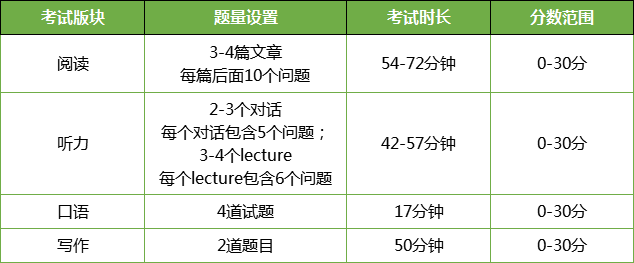据教育部通知,为防控新冠疫情,决定取消5月份所有托福考试,所交考试费均退还至学生账户。考生可再次预约后续日期的TOEFL考试。从整体趋势来看,ETS增加接下来几个月的考试场次,例如6月13、14、20日考试;7月已设4、5、11日考试。此种情况下,在大学申请截止日期前,选报时间靠后的TOEFL比较稳妥。在转考期间,除了继续备考托福,做题练手,考生还可以完善个人申请材料,确认是否有遗漏。
说到托福考试,它常与雅思并称,作为申请国外留学必要提交的语言成绩证明。TOEFL考试包括阅读、听力、口语、写作四个部分:阅读——测试考生对英文学术资料及教学文本的理解能力;听力——测试考生对英文教学环境适应力;口语——考察学生在全英场合中运用英文交谈的能力;写作——测试考生学术英文写作能力。每部分的题量设置及考试时长如下图所示:

托福考试在去年8月份经历一次考题更新:总考试时长由3.5h缩短为3h,阅读及听力的文章对话题量减少,但考试难度整体不变,写作部分未变,TOEFL满分仍为120分。相当于在托福阅读及听力两部分,考生的单位做题时间有所增加。本文将针对托福阅读备考技巧提出建议,此为优朗托福考试培训老师据教学经验总结所得,希望能够帮助考生稳定军心,迎战迟来的TOEFL!
1、托福考试阅读部分备考技巧
根据托福考试培训的实际教学经验,优朗老师发现在四大版块中,阅读部分是比较容易拿分的一项。TOEFL官方也作出说明:“若考生发现阅读篇章涉及到自己不熟悉的主题,也不必担心,因为文后问题答案的关键信息都可以在文中找到。”因此,第一个托福阅读备考技巧是“先调整好心态”,不要看到陌生的主旨就心态崩坏,打退堂鼓。在开始介绍后续托福阅读备考技巧之前,我们先了解下TOEFL阅读所考察内容及文后题目常考偏向?
纵观TOEFL托福阅读部分,优朗托福考试培训老师认为试卷所引用的文本材料大致分为“exposition、argumentation、historical”三种基本类型。第一类解释说明型即对某现象或事物进行阐述,介绍其特点或造成的后果及形成原因;第二类立论型全篇采用议论文形式,针对主论点从正反多方角度进行阐述,也可能站在正方或反方立场去驳斥对方;第三类历史题材型文本往往涉及特殊人物或历史事件。其次,关于托福阅读文后题目,约有8种常考题型:①文本词汇;②插入一句话;③将文句简化;④提问目的;⑤图标题;⑥推断、预测;⑦提问细节信息;⑧提问文章主旨(通常是最后一题、6选3),考察学生是否能把握全局,总结文章主题。
托福阅读备考技巧二:边读边答,文段与题目相对应。与其他阅读考试不同,由于托福阅读部分每篇后附10道题目,据优朗托福考试培训老师总结,几乎大部分题目都可在文中找到对应的某一段,因此,考生在读到重点段落时便可翻到文后答题。这种“边读边答”方法,既节省了考生阅读文本时间,又有利于提升答题正确率。
托福阅读备考技巧三:词汇量达标,结合语境巧猜单词。优朗托福考试培训老师提醒大家考试词汇达标通常可以解决大部分问题,TOEFL要求的词汇量为8000-10000,要想达标,不是易事,需要制定单词背诵目标,坚持打卡。对于词汇量足够的考生来讲,托福阅读词汇题不在话下,用几秒钟选出答案,为其他题目争取更多的答题时间。若遇到不认识的单词,就需要发动“猜词大法”,结合上下文语境推导最接近的词义。无论是“直接选答案”还是“巧妙猜词”,都需要词汇量做基底。因此,优朗老师往往会在课程初期便要求考生严格执行“记忆单词”计划,定时定量抽查单词,检测是否达成小目标。

托福阅读备考技巧四:不脑补,回归原文本确定答案。在TOEFL阅读中,会出现单项、多项两种选择题,作答时,“排除法”是一大利器。如何运用排除法,发挥出它的最大效果?优朗托福考试培训老师建议大家“用原文本说话”,不添加个人感情色彩。通常,排除法的干扰选项为“95%与文本相同,5%为主观编造”,考生首先要根据题目确定答案范围,可能会涉及2-3段,随后根据选项找文本,“有相似之处但出现意义相反的词,不选”,不过有的选项会对原文进行总结,并非完全一致,这样的答案可以保留,若无更合适的,可选这一项。
托福阅读备考技巧五:研读文本,学会分析长难句。“长难句”是近年来英语语言考试中避不开的一部分,尤其出现在各类阅读题中。托福阅读备考时学会解读长难句,更有助于读懂文义,有的题目也会问道长难句中某个词汇的含义,若理解句意,可以便于猜词。针对长难句分析解读,优朗托福考试培训老师建议大家从阅读真题入手。说到底,英语长难句考察学生能否准确拆分句子结构及逻辑,虽然会花费不少时间,但是在练习备考阶段,对此付出的时间成本是值得的,熟练掌握句型后,正式参加考试时便可从容不迫。除了长难句逻辑理清外,大家还可以注意一下文段之间的逻辑关系,是递进、并列还是转折,掌握这些内容,文章主旨题小菜一碟!
2、免费TOEFL真题下载
下面是一篇TOEFL真题阅读文本,大家可以尝试做一下,文后附有真题答案可核对。
Read the passage. Give yourself 20 minutes to complete this practice set.
The Rise of Teotihuacán
1、The city of Teotihuacán, which lay about 50 kilometers northeast of modern-day Mexico City, began its growth by 200 –100 B.C. At its height, between about A.D. 150 and 700, it probably had a population of more than 125,000 people and covered at least 20 square kilometers. It had over 2,000 apartment complexes, a great market, a large number of industrial workshops, an administrative center, a number of massive religious edifices, and a regular grid pattern of streets and buildings. Clearly, much planning and central control were involved in the expansion and ordering of this great metropolis. Moreover, the city had economic and perhaps religious contacts with most parts of Mesoamerica (modern Central America and Mexico).
2、How did this tremendous development take place, and why did it happen in the Teotihuacán Valley? Among the main factors are Teotihuacán's geographic location on a natural trade route to the south and east of the Valley of Mexico, the obsidian1 resources in the Teotihuacán Valley itself, and the valley's potential for extensive irrigation. The exact role of other factors is much more difficult to pinpoint —for instance, Teotihuacán's religious significance as a shrine, the historical situation in and around the Valley of Mexico toward the end of the first millennium B.C., the ingenuity and foresightedness of Teotihuacán's elite, and, finally, the impact of natural disasters, such as the volcanic eruptions of the late first millennium B.C.
3、This last factor is at least circumstantially implicated in Teotihuacán's rise. Prior to 200 B.C., a number of relatively small centers coexisted in and near the Valley of Mexico. Around this time, the largest of these centers, Cuicuilco, was seriously affected by a volcanic eruption, with much of its agricultural land covered by lava. With Cuicuilco eliminated as a potential rival, any one of a number of relatively modest towns might have emerged as a leading economic and political power in Central Mexico. The archaeological evidence clearly indicates, though, that Teotihuacán was the center that did arise as the predominant force in the area by the first century A.D.
4、It seems likely that Teotihuacán's natural resources—along with the city elite's ability to recognize their potential — gave the city a competitive edge over its neighbors. The valley, like many other places in Mexican and Guatemalan highlands, was rich in obsidian. The hard volcanic stone was a resource that had been in great demand for many years, at least since the rise of the Olmecs (a people who flourished between 1200 and 400 B.C.), and it apparently had a secure market. Moreover, recent research on obsidian tools found at Olmec sites has shown that some of the obsidian obtained by the Olmecs originated near Teotihuacán. Teotihuacán obsidian must have been recognized as a valuable commodity for many centuries before the great city arose.
5、Long-distance trade in obsidian probably gave the elite residents of Teotihuacán access to a wide variety of exotic goods, as well as a relatively prosperous life. Such success may have attracted immigrants to Teotihuacán. In addition, Teotihuacán's elite may have consciously attempted to attract new inhabitants. It is also probable that as early as 200 B.C. Teotihuacán may have achieved some religious significance and its shrine (or shrines) may have served as an additional population magnet. Finally, the growing population was probably fed by increasing the number and size of irrigated fields.
6、The picture of Teotihuacán that emerges is a classic picture of positive feedback among obsidian mining and working, trade, population growth, irrigation, and religious tourism. The thriving obsidian operation, for example, would necessitate more miners, additional manufacturers of obsidian tools, and additional traders to carry the goods to new markets. All this led to increased wealth, which in turn would attract more immigrants to Teotihuacán. The growing power of the elite, who controlled the economy, would give them the means to physically coerce people to move to Teotihuacán and serve as additions to the labor force. More irrigation works would have to be built to feed the growing population, and this resulted in more power and wealth for the elite.
说明: obsidian: a type of volcanic glasslike rock used for manufacturing tools and ceremonial objects
Directions: Answer the questions.
1、In paragraph 1, each of the following is mentioned as a feature of the city of Teotihuacán between A.D. 150 and 700 EXCEPT:
A.regularly arranged streets
B.several administrative centers spread across the city
C.many manufacturing workshops
D.apartment complexes
2、The word "ingenuity" in paragraph 2 is closest in meaning to:
A.ambition
B.sincerity
C.faith
D.cleverness
3、Which of the following is NOT mentioned in paragraph 2 as a main factor in the development of Teotihuacán?
A.The presence of obsidian in the Teotihuacán Valley
B.The potential for extensive irrigation of Teotihuacán Valley lands
C.A long period of volcanic inactivity in the Teotihuacán Valley
D.Teotihuacán's location on a natural trade route
4、What can be inferred from paragraph 3 about Cuicuilco prior to 200 B.C.?
A.It was a fairly small city until that date.
B.It was located outside the Valley of Mexico.
C.It emerged rapidly as an economical and political center.
D.Its economy relied heavily on agriculture.
5、Which of the following allowed Teotihuacán to have "a competitive edge over its neighbors"?
A.A well-exploited and readily available commodity
B.The presence of a highly stable elite class
C.Knowledge derived directly from the Olmecs about the art of toolmaking
D.Scarce natural resources in nearby areas such as those located in what are now the Guatemalan and Mexican highlands
6、According to paragraph 4, what has recent research on obsidian tools found at Olmecsites shown?
A.Obsidian's value was understood only when Teotihuacán became an important city.
B.The residents of Teotihuacán were sophisticated toolmakers.
C.The residents of Teotihuacán traded obsidian with the Olmecs as early as 400 B.C.
D.Some of the obsidian used by the Olmecs came from the area around Teotihuacán.
7、Select the TWO answer choices that are mentioned in paragraph 5 as being features of Teotihuacán that may have attracted immigrants to the city. To receive credit, you must select TWO answers.
A.The prosperity of the elite
B.Plenty of available housing
C.Opportunities for well-paid agricultural employment
D.The presence of one or more religious shrines
8、In paragraph 6, the author discusses "The thriving obsidian operation," in order to:
A.explain why manufacturing was the main industry of Teotihuacán
B.give an example of an industry that took very little time to develop in Teotihuacán
C.illustrate how several factors influenced each other to make Teotihuacán a powerful and wealthy city
D.explain how a successful industry can be a source of wealth and a source of conflict at the same time
9、In paragraph 1 of the passage, there is a missing sentence. The paragraph is repeated below and shows four letters (A, B, C, and D) that indicate where the following sentence could be added.
In fact, artifacts and pottery from Teotihuacán have been discovered in sites as faraway as the Mayan lowlands, the Guatemalan highlands, northern Mexico, and the Gulf Coast of Mexico.
Where would the sentence best fit?

A.Option A
B.Option B
C.Option C
D.Option D
10、Directions: An introductory sentence for a brief summary of the passage is provided below. Complete the summary by selecting the THREE answer choices that express the most important ideas in the passage. Some sentences do not belong in the summary because they express ideas that are not presented in the passage or are minor ideas in the passage. This question is worth 2 points.
A.The number and sophistication of the architectural, administrative, commercial, and religious features of Teotihuacán indicate the existence of centralized planning and control.
B.Teotihuacán may have developed its own specific local religion as a result of the cultural advances made possible by the city's great prosperity.
C.Several factors may account for Teotihuacán's extraordinary development, including its location, rich natural resources, irrigation potential, intelligent elite, and the misfortune of rival communities.
D.As a result of its large number of religious shrines, by the first century A.D., Teotihuacán became the most influential religious center in all of Mesoamerica.
E.In many important areas, from the obsidian industry to religious tourism, Teotihuacán's success and prosperity typified the classic positive feedback cycle.
F.Although many immigrants settled in Teotihuacán between A.D. 150 and 700, the increasing threat of coerced labor discouraged further settlement and limited Teotihuacán's population growth.
TOEFL阅读真题参考答案:1.B; 2.D;3.C; 4.D; 5.A; 6.D; 7.A、D;8.C;9.D;10.A、C、E;
通过真题测验,你对托福阅读考试是否已有初印象?最后,优朗托福考试培训老师还要提出最后一条阅读备考技巧——“分析错题,做好反思与总结“。要做到这一点,需要大家在练习TOEFL真题后,想想,在这篇阅读中,我做错了哪道题?是不是因为没读懂题目 or 没读懂选项?这道题涉及长难句吗,是因为不会拆分句子逻辑导致无法理解句意吗?或者本来可以选对,结果想当然,多虑了一步反而选错?这些问题是常见的错选原因。经过反思之后,将经验用在下一次练习中,脚踏实地查漏补缺。如需要专业英语老师辅导,大家可以联系优朗托福考试培训课程顾问老师,了解详细的时间及模式安排,还可以获取更多TOEFL真题!













